Luxury Travel Review

Secluded luxury property offered easy access to airport in Arusha, Tanzania
Article and photos by Josette King
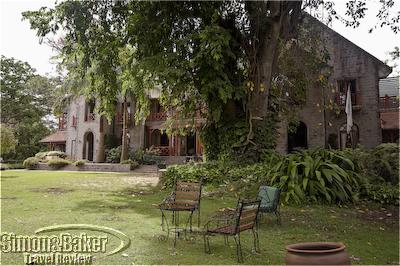
The lodge was a colonial era country manor
Arusha has come a long way since in its origins as a sleepy early 20th century garrison town. Built by Germany as its center for colonial administration of the area, it was then little more than a backwater boma (fortified enclosure) and a few shops in a corner of the northern highlands of what is now Tanzania. A few decades later, the development of commercial air travel, and with it the popularity of mass tourism, changed all that. Ideally located within easy reach of Mount Kilimanjaro as well at the famed safari destinations of northern Tanzania (Serengeti, Ngorongoro Crater and Lake Manyara, a.k.a. the Northern Circuit), Arusha was poised for explosive growth.

A mahogany-paneled bar occupied the rear wall
Today, with Kilimanjaro International Airport within an hour’s drive, the city has become a necessary stopover for most of the of the 300,000 foreign travelers that arrive there yearly, on the their way to the Northern Circuit via Arusha’s own small domestic airport. Modern international-style hotels are springing up throughout the town, along with all the businesses that cater to tourists; and the colorful chaos inherent in a booming African city of 400,000 inhabitants.
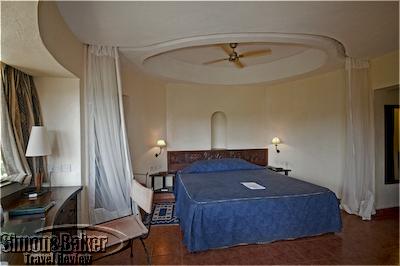
The sleeping area had mosquito netting draperies
However, when traveling to and from the bush my personal choice is for a more serene transition. I had already been in Tanzania for two weeks, visiting the remote parks in the south of the country by the time I arrived in Arusha to enter the Northern Circuit. When lack of coordination between the schedules of the various small local airlines that serve the two areas necessitated an overnight stopover, I turned my attention to hotel options in the outskirts of the city. I was delighted to discover the Serena Mountain Village.
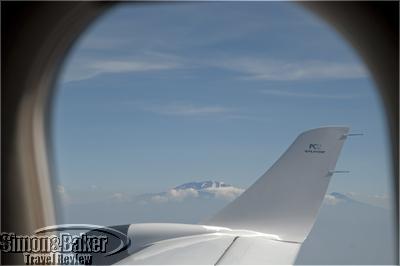
A bird’s eye view of Mount Kilimanjaro
Located on the shore of Lake Duluti in the verdant foothills of Mount Meru, the property was a tranquil luxury retreat a mere 12 miles from Arusha. I loved the English country manor atmosphere of the main lodge, the contemporary comforts of the guest accommodations located in lush gardens overlooking the lake and the warm welcome of the well-trained staff. And when time came for my early morning flight to the Serengeti, I appreciated that Arusha airport was a stress-free 20 minute drive away.
Visit the Simon & Baker Travel Review to read more about Tanzania and my stay at the Serena Mountain Village.
An ideal wildlife guidebook for Antarctica
By Matthew Harris

Antarctic Wildlife book cover
Photos: Princeton University Press
The allure of Antarctica’s vast wilderness captures my imagination, particularly as it is home to some of the world’s most beautiful wildlife, living in a pristine environment devoid (mostly) of troublesome humans. Identifying this wildlife can be quite a challenge for amateur and expert alike, so having a comprehensive field guide is a must for the discerning traveler heading south. Antarctic Wildlife A Visitor’s Guide (Princeton University Press, $22.95) by James Lowen is just such a guide, written by an accomplished guidebook author who brings to bear his experience as an Antarctic naturalist guide working for Polar Star Expeditions.
The first part of the book provides information on conservation, choosing an Antarctic cruise, tips on identifying wildlife, and the animals that might be encountered in each of three regions visited on a typical cruise leaving from South America. The second part is a field guide with 155 pages of wildlife identification photos and supporting text.
Having visited Antarctica I found the background information in the first part of the book to be accurate and informative, especially with regard to choosing an ecologically sound cruise and the potential seasickness perils of the infamous Drake Passage. That said, since the main aim of this book is to be a field guide, some may find these sections a bit brief compared to dedicated books on topics such as Antarctic conservation.
The wildlife introduction and identification tips are clear and should be a great help to those new to wildlife observation. One well thought out aspect of the book is that the author summarizes the animals and plants which might be encountered in each of three geographic regions: The Beagle Channel, Drake Passage, and Antarctic Peninsula. These summaries include look up tables the reader can use to jump to more detailed Species Accounts in the main field guide section. Since the vast majority of Antarctic cruises visit these three regions, this layout should enable the reader to identify wildlife quickly in the field.
The book really comes into its own with the main field guide section. Each page has Species Accounts with accompanying photos. The exceptions are especially notable animals which have longer dedicated sections (e.g. Penguins). The text provides details on how to identify each animal as well as interesting tidbits of information called Talking Points. Also included are tables listing rarity, conservation status, species metrics and the area where each animal is typically encountered.
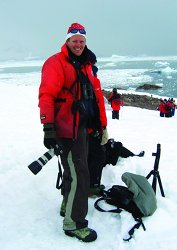
James Lowen, author, Antarctic Wildlife
The identification text is split into two sections, one basic summary for the amateur and beneath this a more detailed description for the avid enthusiast. The supporting images are excellent, chosen for clear field identification, and it’s impressive to note that the author took many of them himself. Overall the list of animals seems comprehensive and covered everything I saw on my trip, plus a host I would hope to see the next time I visit.
This is an excellent field guide, well laid out with photos and easy-to-access information. The guide has good emphasis on conservation throughout and some of the proceeds go to the Save the Albatross campaign. It will definitely accompany me on my next trip to Antarctica.

Click to buy Antarctic Wildlife
Castle near Dublin, Ireland good for last night stay before international departure
Article and photos by Laura Scheiber
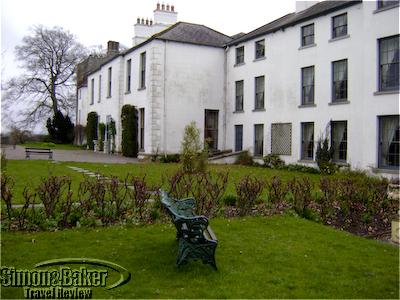
Exterior of Barberstown Castle
When catching an international flight, it is comforting to know that traffic to the airport will not be an issue. Thanks to its location near the airport Barberstown Castle offered this security and also provided a unique experience of staying in a four-star medieval castle previously owned by Eric Clapton.
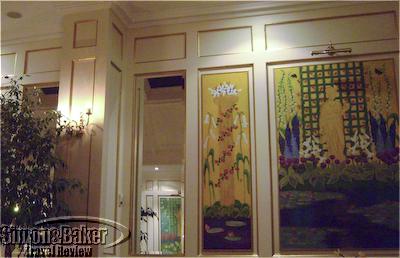
Art in the lobby area of Barberstown Castle
My travel partners and I arrived at Barberstown Castle, located a half hour outside of Dublin city center, in the late afternoon after five days of touring South East Ireland. Candy, a 15 year-old golden retriever who made her home at the castle, greeted us with a wag of her tail as we entered the naturally-lit cheerful lobby. A friendly and unassuming receptionist showed me to room 59.

Room 59 at Barberstown Castle
Although the view looked out onto a parking lot, the room was clean and spacious with a double and twin bed. Details that contributed to the cozy ambiance of the room included an attractive glass chandelier and antique furniture that fit the castle setting. As it was a blustery evening, I appreciated the plush bathrobe and towels hanging on an electric towel warmer.
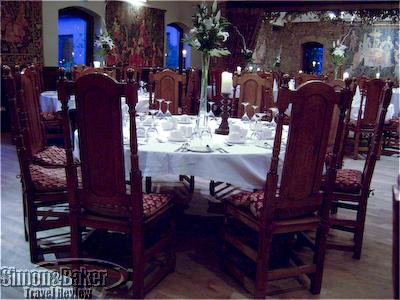
Table used for receptions
Just before dinner, my travel companions and I enjoyed complimentary champagne in the lobby before getting a tour of the castle. Originally built in 1288, the current proprietor, Kenneth Healy, bought the castle in 1987 from Eric Clapton and converted the 10-bedroom guesthouse to 59 bedrooms. While the oldest section dated back to medieval times, additional wings had been added on during Victorian and Elizabethan times. The castle maintained its historic infrastructure and design, and also incorporated modern comforts, such as heating and a pleasant sitting area with large glass windows looking out onto the property’s well-manicured gardens.

Dining in the 13th century castle
We enjoyed a delicious six-course dinner in the oldest section of the castle. The candle-lit room added to the already enigmatic atmosphere. After dinner we moved to the cozy bar area and enjoyed live Irish music with a professional singer, flutist and traditional Irish bodhran drummer.
The next day we headed to the airport for our return to the United States. The route from Barberstown Castle was on a motorway with no major traffic lights. As promised, we made it to the airport in 30 minutes.
My stay at the castle (Barberstown Castle, Straffan, County Kildare, Ireland, telephone +353 1 6288157, http://www.barberstowncastle.ie/) was a delightful way to wrap up my Irish holiday. The castle’s unique setting dating back from medieval, Victorian and Elizabethan times, the tasty dinner, hospitable staff, live Irish music and close proximity to the airport offered an enjoyable alternative to staying in Dublin city prior to departing Ireland.
Tanzania luxury properties with strong community involvement delivered outstanding safari experience
Article and photos by Josette King
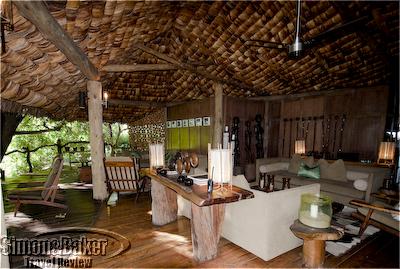
The main lodge at Lake Manyara opens onto a deck
Having enjoyed memorable safari experiences at &Beyond lodges and camps during a previous visit to Southern Africa, I was delighted to include three of their properties in my recent itinerary around Tanzania. All three were located in the Northern Circuit of the country, in the legendary destinations of the Serengeti, Ngorongoro Crater and Lake Manyara. And all three delivered superb guiding, outstanding comfort and attentive service. But then, that is considered de rigueur from any reputable luxury safari organization. So, I asked myself, what is the magic ingredient that makes the &Beyond properties I have stayed at stand out in my mind? There are two actually:
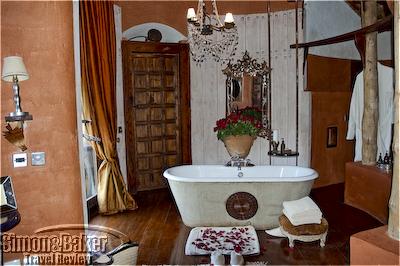
A welcome rose petal bath at Ngorongoro Crater
First, there is Chris Browne, &Beyond’s creative director, the versatile wizard who conjures up for each property an unpredictable and sometimes improbable environment fully integrated within its distinctive surroundings. Each location was a new aesthetic surprise for me with its unique personality but always merely a setting for uncompromising comfort.

The lounge at Serengeti Grumeti Tented Camp
My first stop of the Northern Circuit was Serengeti Grumeti Tented Camp, in the far northern reaches of the Serengeti National Park. Although just a short drive from the pale grasslands and stark vistas of the “endless plain,” the camp was nestled along the verdant bank of the Grumeti River. To further play on this contrast the décor was an explosion of colors and entertaining details. The lime green sofas of the lounge had vibrant blue and orange pillows that contrasted further with the bright purple market umbrellas and seat cushions of the deck furniture. Whimsical interpretations put a new spin on traditional arts, with light fixtures of fine Masai beadwork and witty polychrome woodcarvings of men in costumes of the colonial era standing guard in a corner of the lounge. It was impossible not to be in a playful mood at this camp.
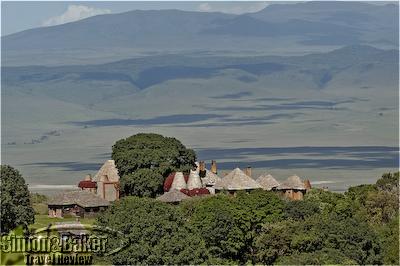
The lodge is perched at the very rim of the Ngorongoro Crater
My next destination was the Ngorongoro Crater Lodge. There, in a fairytale mud and brick village balanced on the very rim of the largest intact caldera on the planet, a Victorian extravaganza awaited, its tongue-in-cheek glamour a perfect foil for the breathtaking scenery below. In generous spaces where rich Zanzibar paneling alternated with whitewashed plaster, miles of raw silk draped soaring French windows, antique mirrors reflected crystal chandeliers, and overstuffed cut velvet sofas were piled with jewel-toned pillows. On 19th century guéridons, urns filled with long-stem roses alternated with fine bronzes of big game and flowing art-nouveau statuettes. Even my bathroom had its own chandelier and Persian carpet!

My room at Lake Manyara
The last stop of my journey was Lake Manyara Tree Lodge, a serene retreat tucked in a dense forest of ancient mahoganies, in the foothills of the Rift Valley escarpment, a mere 10 minute drive from the lake shore. Here minimalist luxury prevailed, with clean-lined contemporary furniture and neutral tones. Public areas opened onto a large circular boma (fenced enclosure) with its own brick oven barbecue and central campfire for romantic fireside dinners under the stars. My suite was a genuine tree house, set on a platform perched on stilts high in the boughs of the forest. Screened-in outer partitions opened onto a large veranda that seemed to melt into the forest beyond. I enjoyed eye-level contact with the rich bird-life and the occasional overhead visit of the rarely seen blue monkeys. I couldn’t have wished for a more inspiring environment to bid goodbye to Africa, and relax before the long journey home.

A herd of wildebeests rushes past at Lake Manyara
The second ingredient in the &Beyond magic comes from its multi-level involvement in the local community. Managers told me of priority local hiring of their staff, cross-functional training and internal promotion practices. Young butlers eager to show off their language skills spoke to me of the company-sponsored English lessons; some confided their aspirations to become rangers, and pointed to guides that had started as household staff. At Serengeti Grumeti camp, I had the pleasure to congratulate May Kobero, who after several years in increasing levels of administrative positions, had been officially promoted to the camp’s top job that very morning. I was heartened to find several women in managerial and professional positions (including two women guides at the Crater Lodge). This in turn fosters an enthusiasm and pride in being “&Beyonders” as the staff likes to call themselves that is directly reflected in the quality of service I enjoyed during my stay.
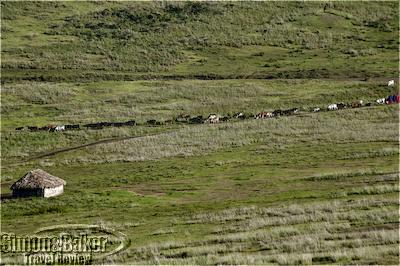
Masai shepherds guide their cattle down the outer edge of the Ngorongoro Crater
Then there is the grass-root level involvement in the community at large: fresh produce purchased from local growers who practice chemical-free farming (from seeds donated by &Beyond), honey from local hives, and the work of local craftspeople integral in the décor of the camps and sold at the camp boutiques. And most importantly, through the &Beyond Foundation, there is the extensive effort to promote literacy in local children. Each property sponsored a school (two of which I had the pleasure to visit) that serves surrounding villages and educates around 600 children. Efforts can range from providing the most basic necessities such as windows, desks and sanitary facilities as well as school supplies, to starting a kindergarten where Masai children can learn Swahili before they enter primary school.
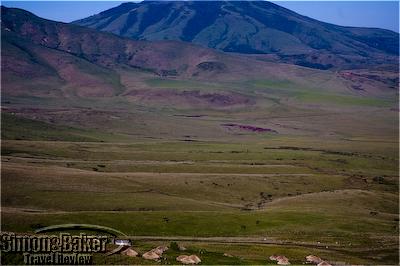
Masai village near the Ngorongoro Crater
There is a special focus on promoting school attendance for girls. Additionally there is an extensive effort on the part of the guides who volunteer their time to educate children on conservation and game protection issues. During the low season they also arrange game drives for the best performing pupils (competition is intense!). And &Beyond encourages Masai adolescents to preserve their cultural heritage. Twice per week during the year a large group of high-school children are bussed from surrounding villages to the Ngorongoro Crater Lodge where they perform their traditional dances and songs for the guests. This is a much sought-after opportunity, as in addition to earning a stipend for their performance, there is an ancillary perk. I noticed a discrete undertone of boys and girls from different villages “checking each other out” throughout the evening.
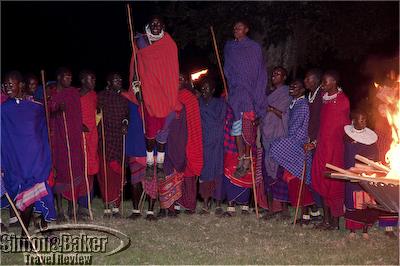
Masai students demonstrate their jumping skills for Crater Lodge guests
It is this multi-faceted combination of aesthetic enjoyment drawn from the luxurious and witty environments created by Chris Browne coupled with the pride and enthusiasm of the staff, as reflected in the superb quality of service, that has made my stay at these properties consistently memorable. As for the for community involvement of &Beyond, it addresses my ever present concern about the impact of luxury tourism on local populations. It enables me to better enjoy the superb accommodations and hospitality of the properties, knowing that my visit contributes, however modestly, to providing growth opportunities to the local population while helping preserve their culture and natural environment.

Masai students share their traditional dances with Crater Lodge guests
Visit the Simon & Baker Travel Review to read more about my visit to Tanzania, Serengeti Grumeti Tented Camp, Ngorongoro Crater Lodge and Lake Manyara Tree Lodge.
Osaka museum showcases electronic company history
Article and photos by Joachim Castellano
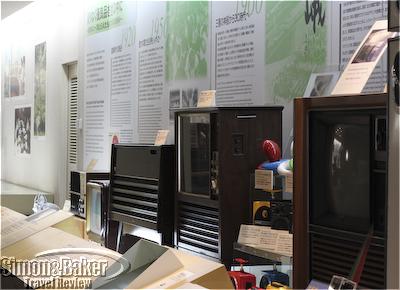
Early Panasonic radios and tape players
The Konosuke Matsushita Museum, established 1968, is a small one-story exhibition space located on the campus of the global giant electronics company, Panasonic. The museum, located about 20 kilometers from Osaka, tells the story of the stratospheric rise of Panasonic’s founder Konsuke Matsushita to one of the world’s most successful industrialists. Inside a cozy building modeled after the original 1933 Panasonic head office many first generation consumer electronics are on display, from TVs to washing machines.
It was fascinating to see the initial models, whose design genius us modern folk have come to ignore like windows and doorknobs. Panasonic’s first radio, made of beautiful wood with a distinctive octagonal speaker, was likely met with the same jaw-dropping awe awarded to today’s smartphones and tablet computers. To the digital generation, these gadgets might appear as ancient as Egyptian artifacts. However, digital DJ’s should pay respects and bow at the altar of the Technics Turntable record player, a key tool that set stage for art forms such as hip hop and dance music.

Early models of televisions and washing machines on display
The museum is not just a historical hit parade for Panasonic merchandise. I glimpsed into a time capsule of Japanese history after the devastation of World War II. On display are copies of Time and Life Magazine from the 1960s whose cover stories feature Japan. It was interesting to witness the American media coverage of Japan’s transformation as it was happening. The issue of Time on display features an interview with Matsushita, whose success story parallels Japan’s rise as an economic superpower.
Aspiring CEOs might also find golden nuggets of advice from Matsushita’s teachings on business. His process, I had the impression, created global hit products for decades. The basic business principles he developed are still practiced by Panasonic today. The future Bill Gates or Steve Jobs should not miss visiting this gem of a museum.
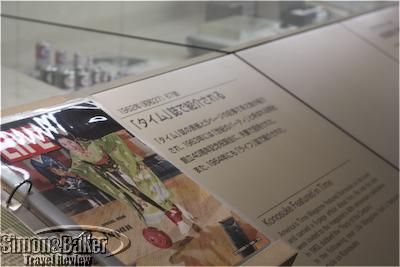
Early magazine articles from Time and Life were on display
Signage and information was available in Japanese and English. A few video and audio clips were in Japanese only. The museum, owned and managed by Panasonic Corporation, was a three minute walk from Nishi-sanso station on the Keihan Line.
The Konosuke Matsushita Museum might be small in size, but it is rich in Japanese and electronics history. It houses models of the world’s first VHS VCR along with information about post-war Japanese history and corporate management. Konosuke Matsushita Museum, 1006, Kadoma, Kadoma City, Osaka 571-8501, Japan, + 81 06-69 060 0106, fax: + 81 06 69 06 1894, http://panasonic.net/history/museum
Dar es Salaam harbor front landmark hotel made an ideal luxury stopover
Article and photos by Josette King
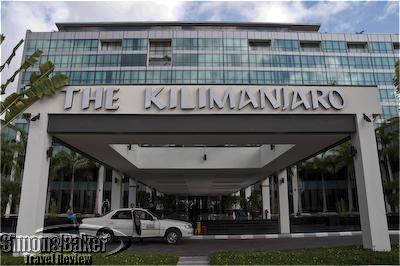
The facade of the Kilimanjaro Kempinski Hotel
It’s a long way from North America to Tanzania, and there is no easy way to get there. Although I had treated myself to a weekend stopover in Europe, the remaining leg of my journey had started with a pre-dawn wake-up call, then the long hours of pre-departure chaos inherent to large international airports. The flight seemed to go on forever, as did arrival formalities. It was past midnight by the time I shuffled into the poorly lit arrival hall at Dar es Salaam International Airport, travel-worn and circumspect. This was my first visit to Tanzania and all that I had heard of the city’s reputation for crime and petty theft dictated vigilance. Then a sign caught my eye, held by a smiling man. “Kili Kempinski,” the sign said, with my name neatly printed below. All was well!

The foyer
Comfortably settled in the late model, air-conditioned car, a bottle of chilled water in hand, I watched the gloomy empty streets zoom by, thankful for the efficient staff of the Kilimanjaro Hotel Kempinski who had arranged my airport transfers. Soon, we were entering a gated garden and pulling under the deep canopy of the hotel entrance. I was welcomed by an awaiting doorman who ushered me to the reception desk. The Kili (as the hotel is affectionately known by its local patrons) clearly understands middle-of-the-night arrivals, and how to whisk guests to their bed in record time. I barely had a chance to catch in my peripheral vision the cool white marble foyer with its line of rosewood-clad pillars and large turquoise ceramic urns filled with greenery, before I was in the elevator to my room.

My room at the Kempinski
There, luxurious contemporary décor hinted at the promise of a serene night’s sleep. Subdued lighting filled the room with a warm glow revealing the king size bed, its silky high-count cotton bedding invitingly turned down. Crimson velvet drapes were cozily drawn across the long picture window. I hesitated briefly at the tempting sight of the deep freestanding tub in the center of the ultra-modern bathroom before stepping into the walk-in shower. My next recollection is of a wake-up call pulling me out of the embrace of my ultra-comfortable bed. I opened the drapes to a panoramic view of the harbor. Against a backdrop of modern infrastructure and large cargo ships, a lone dhow, its traditional triangular sail arching in the morning breeze, was slowly making its way across the water as dhows have for centuries. This was indeed the Indian Ocean, and the Kili the perfect place to catch my breath before starting off on my safari.
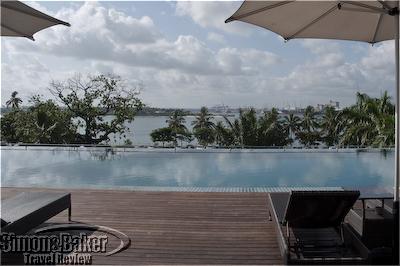
The pool area looks out over the harbor
Originally open in 1965 as the first contemporary luxury hotel in Dar es Salaam, the property had eventually fallen in disrepair before shutting its doors three decades later. After being shuttered for several years, it was acquired in 2004 by Ali Saeed Juma Albwardy, a United Arab Emirates industrialist who restored the landmark property to its earlier grandeur. Opened in 2005 under the under the management of Kempinski Hotels, it is once again a favorite of the business and political elite of the city. And a stopover of choice for weary travelers who enjoy the Kili’s personalized service and its appealing blend of European comforts and East African hospitality.
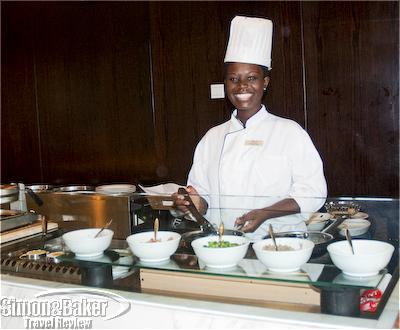
Breakfast in the Palm Restaurant
After a hearty breakfast cooked to order in the open kitchen of the sunny Palm Restaurant, it was time to step into the awaiting car and be driven back to the airport for my flight to Mikumi National Park. I had just enough time before I left to catch a glimpse of the long, shimmering infinity-edge swimming pool on its terrace raised above the harbor, and the serene foyer of the Anantara Spa. This reinforced my conviction that not only would the Kilimanjaro Hotel Kempinski (Kivukoni Street, P.O. Box 9574, Dar es Salaam, Tanzania, + 255 764 704 704, http://www.kempinski.com/en/daressalaam, reservations.tanzania@kempinski.com) be my home in Dar es Salaam whenever travel opportunities in East Africa bring me back to the city, but next time, I will plan a longer stop there. Visit the Simon & Baker Travel Review to read more about my visit to Tanzania.







